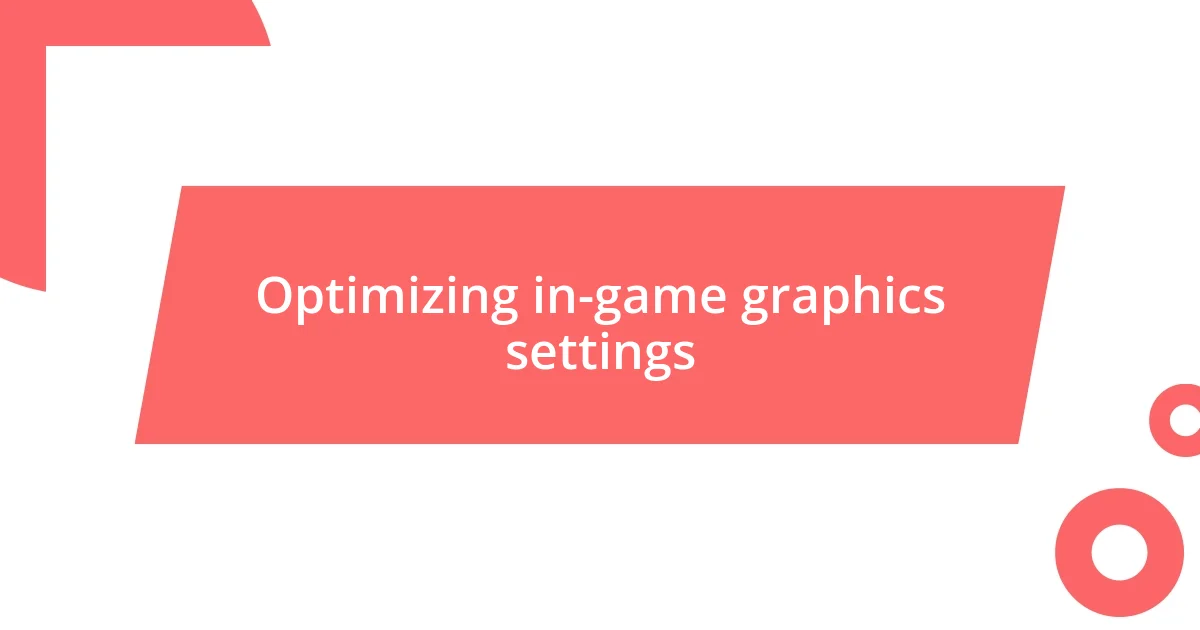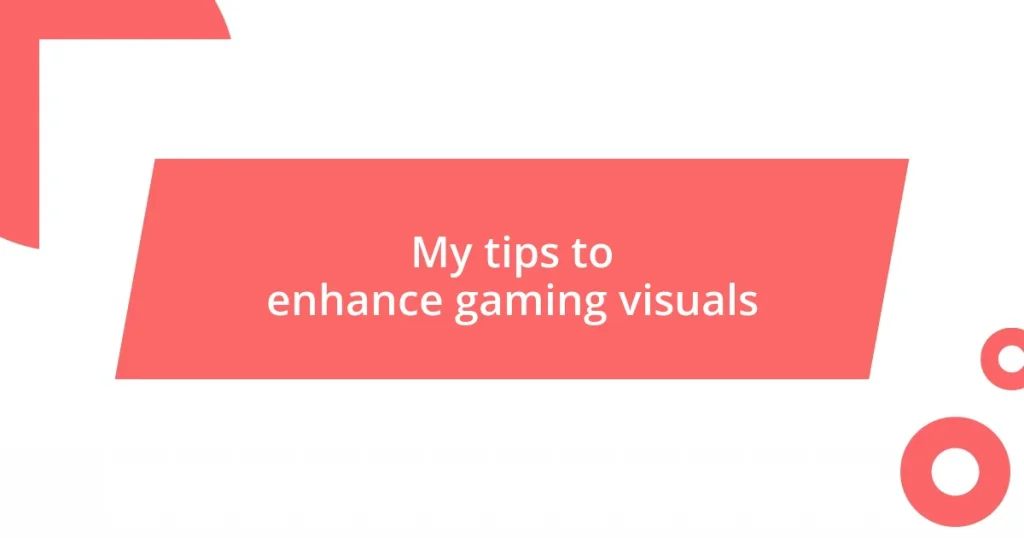Key takeaways:
- Gaming visuals significantly enhance the immersive experience, influenced by color palettes, resolution, and graphical fidelity.
- Optimizing graphics settings such as shadow quality and anti-aliasing can improve both performance and visual appeal, enriching gameplay.
- Adjusting display settings, including brightness, contrast, and refresh rates, can uncover hidden details and elevate the overall gaming experience.

Understanding gaming visuals
Gaming visuals are much more than just eye candy; they create an immersive experience that can transport players into another world. I still remember the first time I loaded up a game with stunning graphics—it felt like I stepped right into the screen. Have you ever had that moment where you just become captivated by the beauty of a vast landscape or a well-crafted character?
The ability to effectively communicate a game’s story and atmosphere heavily relies on visuals. For instance, I’ve noticed that darker color palettes can evoke tension and a sense of foreboding, while bright, vibrant designs often spark joy and excitement. Isn’t it fascinating how colors and textures play such a massive role in shaping our experience and emotions while gaming?
Resolution, frame rate, and graphical fidelity are key elements that enhance the overall visual experience. I’ve experienced the smooth, seamless gameplay that high frame rates provide; it’s almost like watching a fluid animation. Can you recall a moment when a choppy frame rate pulled you out of that immersive state? Understanding these components gives us insight into what makes our gaming experiences truly memorable.

Importance of resolution settings
Resolution settings are crucial when it comes to gaming visuals. Higher resolutions, like 4K, allow for greater detail. I remember the first time I cranked up my settings to 1440p; it was like uncovering a whole new world in a game I thought I knew inside and out. It truly made me appreciate the artistry behind those carefully rendered environments.
However, resolution isn’t just about the numbers. It affects gameplay too. When I switched from 1080p to 1440p, I noticed textures were sharper, and characters appeared more lifelike. The subtle details, like the glint on armor or the shadows cast by trees, added layers to my immersion. Can you think of a moment when a visual detail enhanced your connection to a game?
Misunderstanding resolution can lead to poor experiences. If your hardware isn’t capable of supporting higher settings, you may face lag or frame drops, diminishing the overall enjoyment. I learned this the hard way; I once set my expectations too high, and the subsequent performance issues were frustrating. So, it’s essential to find a balance between stunning visuals and the smooth gameplay that keeps us engaged.
| Resolution | Details |
|---|---|
| 1080p | Standard HD, provides decent visuals, but can look pixelated on larger screens. |
| 1440p | Quad HD, offers a significant upgrade with sharper images and more detail without demanding as much power as 4K. |
| 4K | Ultra HD, provides stunning visuals but requires powerful hardware for smooth gameplay. |

Optimizing in-game graphics settings
When it comes to optimizing in-game graphics settings, knowing how to adjust them can truly transform your experience. I remember a pivotal moment in my gaming journey when I discovered how to balance my settings for performance and aesthetics. By tweaking options like shadow quality and texture detail, I could enjoy a visually stunning game without sacrificing smooth gameplay. One of my favorite tricks is to slightly reduce the anti-aliasing. It’s a small change that often results in a significant performance boost while still keeping the visuals crisp.
Here are some critical settings to consider when optimizing your graphics:
- Shadow Quality: Lowering this can significantly improve frame rates; details become less pronounced, but the game can run smoother.
- Texture Detail: High textures enhance visual richness, but when your GPU is under strain, dialing it back a notch often helps maintain performance.
- Anti-Aliasing: This smooths out edges; I found that reducing it slightly leads to less lag without a noticeable drop in quality.
- Draw Distance: Adjusting how far ahead your game renders can greatly affect performance—an essential tweak for open-world games where vast landscapes are common.
- V-Sync: Activating this can reduce screen tearing but may limit frame rates. Testing both enabled and disabled can help find the sweet spot.
While every game is different, each adjustment feels like a step closer to perfecting that immersive experience. I vividly remember spending hours just finding the right settings for a beautiful sunset in an RPG, where tweaking the lighting options made it feel almost magical. It’s those personal touches and adjustments that not only create captivating visuals but also enhance our emotional connection to the game.

Enhancing color and contrast
When enhancing color and contrast, I’ve found that calibrating your monitor can make a significant difference. I remember one late-night session adjusting my display settings, fine-tuning the gamma, and suddenly the dark scenes in my favorite horror game were rich with detail rather than just shadows. Have you ever experienced a moment where simply adjusting a setting transformed your gaming atmosphere?
Another fantastic way to boost color vibrancy is utilizing color grading filters. Many display settings offer options like “vivid” or “dynamic” modes; I once switched to a more saturated palette while playing a colorful platformer and felt like I was seeing everything for the first time. The bright blues and fiery reds created an almost surreal experience, drawing me deeper into the world.
Contrast ratios also play a pivotal role in how we perceive visuals. Higher contrast can make game elements stand out, enhancing your immersive experience. I vividly recall an FPS where lowering the contrast helped me spot hidden enemies lurking in shadows that I’d otherwise miss. There’s something thrilling about discovering those little details that can change the tide of gameplay, wouldn’t you agree?

Implementing anti-aliasing techniques
Implementing anti-aliasing techniques can have a profound impact on your gaming visuals. For a long time, I overlooked this setting, assuming it was just a minor detail. However, when I finally enabled it, the difference was astonishing. Suddenly, the jagged edges on character models smoothed out beautifully, offering a more lifelike appearance that pulled me deeper into the gaming world. Have you ever admired how crisp the graphics can look after a simple toggle?
There are various anti-aliasing options to explore, such as FXAA (Fast Approximate Anti-Aliasing) or MSAA (Multisample Anti-Aliasing). I distinctly remember playing a racing game where switching to MSAA made the landscapes and cars look spectacular on curves and corners. Each frame flowed seamlessly, transforming the experience. Yet, I learned that heavier methods can cost some performance, so finding what works best for your hardware is crucial. Testing different settings becomes an exciting part of the journey, don’t you think?
I realized an important lesson: anti-aliasing doesn’t just enhance visuals; it can actually affect gameplay. In a competitive shooter, I noticed that a smoother image made it easier to spot opponents in fast-paced action. It’s those moments when graphics truly do matter—balancing aesthetics with competitiveness can lift the overall experience to new heights. Have you ever considered how much subtle adjustments influence your gameplay? I find that a bit of tweaking often leads to surprisingly enjoyable discoveries.

Exploring advanced rendering options
When I dove into advanced rendering options, the transformation in my gaming experience was palpable. The first time I adjusted the render distance, I was completely blown away by how much more of the world I could see. I vividly recall standing atop a hill in an open-world RPG, gazing at sprawling landscapes that I had previously overlooked. The added detail felt almost like stepping into a painting—have you ever had a moment where the visual depth changed your entire perception of the game?
Tessellation is another feature that can elevate visuals significantly. I remember the first time I noticed it in a fantasy game; the textures and surfaces looked so richly detailed that I could see individual stones on a castle wall. That depth added an extra layer of realism to my adventures. It’s fascinating how these advanced techniques can turn a pixelated world into something that feels alive, isn’t it? I found myself spending extra time just exploring every corner, admiring the craftsmanship.
And then there’s global illumination, which can be a game-changer. When I turned this feature on during some late-night gaming sessions, the way light bounced elegantly through the environment amazed me. Shadows became softer, and everything felt more atmospheric. I can still remember wandering through a dimly lit dungeon where flickering torches created an eerie ambiance; it felt as if the game was telling a story through visuals alone. Have you considered how enhancing these rendering options could affect not just the aesthetics, but your entire immersion in the gameplay?

Adjusting display and monitor settings
Adjusting display and monitor settings can significantly elevate your gaming experience. I remember the first time I tweaked the brightness and contrast settings on my monitor—it was like flipping a switch. The details of the game came to life, especially in darker scenes where previously unseen textures began to emerge. Have you ever wondered how small adjustments can uncover hidden visuals?
Color calibration is another vital aspect that I often overlooked in the past. The difference it made when I adjusted the color balance was nothing short of incredible. In a vibrant, fantastical game, I could finally appreciate the lush greens and deep blues without everything looking washed out. I felt like I had stepped into a whole new world. How important do you think color depth is in enhancing overall immersion?
One of my favorite features is the refresh rate setting. It wasn’t until I upgraded my monitor that I experienced a buttery smooth gameplay at 144Hz. That moment was eye-opening; sudden movements were incredibly fluid, and it felt like I was directly in the action rather than just watching. The adrenaline rush of dodging attacks became more exhilarating—doesn’t a higher refresh rate seem like a game-changer in competitive scenarios? Finding the right balance in monitor settings could be the key to transforming your gaming sessions entirely.















